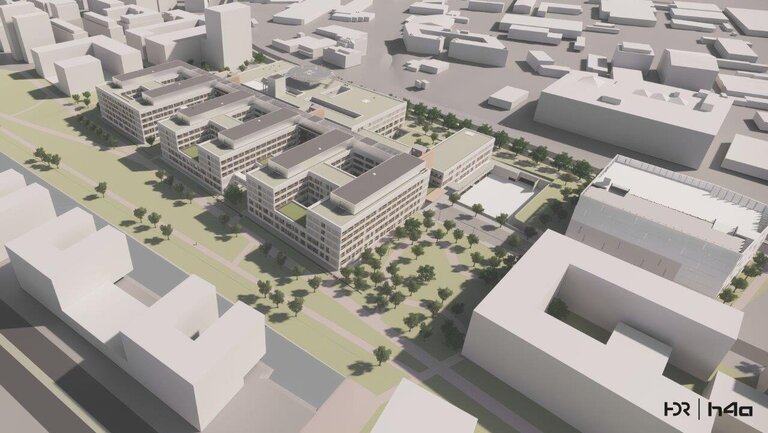Stuttgart, Germany, January 19, 2021. By investing around EUR 570 million in Böblingen’s regional hospitals, the administrative district of the German city of Böblingen intends to make its patient care fit for the future. A new hospital aims to combine the two previously separate facilities in Sindelfingen and Böblingen under one roof and create synergies. The foundation pit has just been completed on site ahead of schedule and most people cannot begin to imagine how a 51,000 m² hospital will soon stand on the former airfield. Yet the building can already be viewed and calculated on the computer, from every angle and with a lot of detail. The construction work will take until 2025. It is being supervised by Drees & Sommer SE, a Stuttgart-based consulting company specializing in construction and real estate.
Pioneer in the German Hospital Landscape
Planning and building can be so easy: when you sit at the computer and see the entire building in front of you with one click, then you feel as if you are already right in the middle of the action, in the new Flugfeldklinik. Every entrance and every window, every pipe, every cable, every room and every operating room can be displayed on the screen and changed. How is that possible? The future Flugfeldklinik has a digital twin. Its likeness exists in virtual space as a three-dimensional visual representation. Building Information Modeling (BIM) is the name of the method behind it, networking all the processes, products and participants in real-time. The new Flugfeldklinik project is one of the first hospitals in Germany to be planned and built completely and consistently with BIM. For Felix Beck, project manager and BIM expert at Drees & Sommer, the advantages are obvious: ‘By using the BIM model, everyone involved in the construction always knows exactly what the other is doing. The digital twin not only shows the geometry of the future building, but also provides information on the materials used at the click of a mouse. Conflicts between the hundreds of thousands of components are detected in the model, and not later on the construction site. The BIM model helps planners communicate better, coordinate all the requirements of each trade perfectly, and so avoid mistakes.’ In the case of Flugfeldklinik, the BIM model accompanies the hospital building throughout its entire service life, from planning and subsequent operation to future remodeling and renovation. Key operational processes can already be visualized and optimized through virtual reality.
Focus on the User
Few buildings are as complex as hospitals, so planning must take a lot of factors into account. Even before the first diggers rolled in to excavate the foundation pit, doctors, nursing staff and workers from the service areas had given thought to the matter in the course of about 200 rounds of consultation and had formulated their requirements and wishes for an optimum working environment. For Harald Schäfer, who heads project management, the project sets the standard: ‘The goal of the new building is to provide the best possible care for patients. How this can be delivered is known best by the staff who deal with this on a daily basis. So, it was important for us to involve the hospital staff closely, right from the beginning. Together, we have developed a viable concept that meets the needs of hospital staff and patients precisely, with short routes and the medical equipment in the treatment rooms.’
For example, suggestions from the workshops can be found in the Central Emergency Department, which will be connected directly to Radiology for all imaging procedures.
The first patients are expected to be admitted to the new hospital at the end of 2025. The new joint hospital for Böblingen and Sindelfingen will also ensure that the regional hospitals in Leonberg, Herrenberg, Calw and Nagold are retained through specialist centers covering multiple locations. This will provide the people of the region with state-of-the-art basic and emergency care close to home, throughout the entire area covered by the health authority.
Your Contact at Flugfeldklinik:
Louisa Oeltjenbruns
Communication Manager
New hospital building Flugfeldklinik
phone: +49 (0)7031 98 11065
mobile: +49 (0)151 67533886
email: l.oeltjenbruns(at)klinikverbund-suedwest.de
About Drees & Sommer SE:
Drees & Sommer SE was established in 1970 in the German city of Stuttgart with a handful of employees. It now has a staff of around 4,000 people at 46 locations worldwide. In 2019, the company generated sales of EUR 500 million. Its architects, engineers, business administrators, designers, chemists, ecologists and other experts are currently working on more than 4,250 projects for private and public clients. The company has extensive experience in public approval proceedings.
